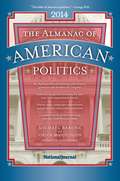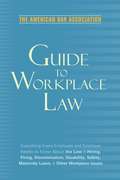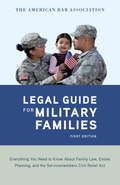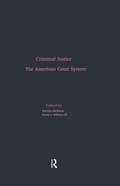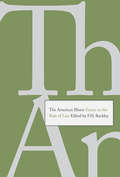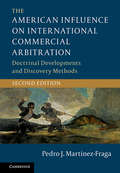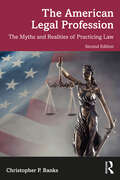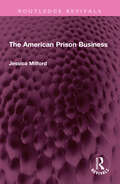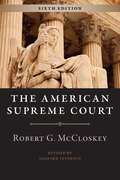- Table View
- List View
The Alien and Sedition Acts of 1798: Testing the Constitution (Witness to History)
by Terri Diane HalperinWhat happens to democracy when dissent is treated as treason?In May 1798, after Congress released the XYZ Affair dispatches to the public, a raucous crowd took to the streets of Philadelphia. Some gathered to pledge their support for the government of President John Adams, others to express their disdain for his policies. Violence, both physical and political, threatened the safety of the city and the Union itself. To combat the chaos and protect the nation from both external and internal threats, the Federalists swiftly enacted the Alien and Sedition Acts. Oppressive pieces of legislation aimed at separating so-called genuine patriots from objects of suspicion, these acts sought to restrict political speech, whether spoken or written, soberly planned or drunkenly off-the-cuff. Little more than twenty years after Americans declared independence and less than ten since they ratified both a new constitution and a bill of rights, the acts gravely limited some of the very rights those bold documents had promised to protect.In The Alien and Sedition Acts of 1798, Terri Diane Halperin discusses the passage of these laws and the furor over them, as well as the difficulties of enforcement. She describes in vivid detail the heated debates and tempestuous altercations that erupted between partisan opponents: one man pulled a gun on a supporter of the act in a churchyard; congressmen were threatened with arrest for expressing their opinions; and printers were viciously beaten for distributing suspect material. She also introduces readers to the fraught political divisions of the late 1790s, explores the effect of immigration on the new republic, and reveals the dangers of partisan excess throughout history.Touching on the major sedition trials while expanding the discussion beyond the usual focus on freedom of speech and the press to include the treatment of immigrants, Halperin’s book provides a window through which readers can explore the meaning of freedom of speech, immigration, citizenship, the public sphere, the Constitution, and the Union.
The Alligator Man
by James SheehanKevin Wylie's crooked boss wants to run him out of town, and Kevin's long-time girlfriend is ready to take a hike. He decides that now is the time to leave Miami, visit his father, who he hasn't seen in 28 years, and get some answers. Heading back to his hometown, he doesn't realize that he and his dad will become embroiled in a murder case. The victim, one of the richest and most-hated corporate criminals in America has been dubbed The Alligator Man since pieces of his clothing were found in a local swamp. Billy Fuller had every reason in the world to want Johnson dead and all the evidence leads right to his doorstep. But legendary trial lawyer Tom Wylie believes in Billy and he and his son reunite to fight the courtroom battle for Billy's life. The Alligator Man is a story of greed, anger, love, redemption and two powerful trial attorneys who fight to the end-- and risk everything--for the truth.
The Allocation of Regulatory Competence in the EU Emissions Trading Scheme
by Josephine Van ZebenThe European Union's Emissions Trading System (EU ETS) is the world's largest carbon trading market. This book offers a new perspective on the EU ETS as a multi-level governance regime, in which the regulatory process is composed of three distinct 'competences' - norm setting, implementation, and enforcement. Are these competences best combined in a single regulator at one level of government or would they be better allocated among a variety of regulators at different levels of government? The combined legal, economic, and political analysis in this book reveals that the actual allocation of competences within the EU ETS diverges from a hypothetical ideal allocation in important ways, and provides a political economy explanation for the existing allocation of norm setting, implementation and enforcement competences among various levels of European government.
The Almanac of American Politics 2014 (Almanac of American Politics)
by Michael Barone Chuck MccutcheonThe Almanac of American Politics is the gold standard--the book that everyone involved, invested, or interested in American politics must have on their reference shelf. Continuing the tradition of accurate and up-to-date information, the 2014 almanac includes new and updated profiles of every member of Congress and every state governor. These profiles cover everything from expenditures to voting records, interest-group ratings, and, of course, politics. In-depth overviews of each state and house district are included as well, along with demographic data, analysis of voting trends, and political histories. The new edition contains Michael Barone's sharp-eyed analysis of the 2012 election, both congressional and presidential, exploring how the votes fell and what they mean for future legislation. The almanac also provides comprehensive coverage of the changes brought about by the 2010 census and has been reorganized to align with the resulting new districts. Like every edition since the almanac first appeared in 1972, the 2014 edition is helmed by veteran political analyst Michael Barone. Together with Chuck McCutcheon, collaborator since 2012, and two new editors, Sean Trende, senior elections analyst for RealClearPolitics, and Josh Kraushaar, managing editor at National Journal, Barone offers an unparalleled perspective on contemporary politics. Full of maps, census data, and detailed information about the American political landscape, the 2014 Almanac of American Politics remains the most comprehensive resource for journalists, politicos, business people, and academics.
The Almighty Latin King and Queen Nation: Street Politics and the Transformation of a New York City Gang
by David C. Brotherton Luis BarriosFrom Los Angeles and New York to Chicago and Miami, street gangs are regarded as one of the most intractable crime problems facing our cities, and a vast array of resources is being deployed to combat them. This book chronicles the astounding self-transformation of one of the most feared gangs in the United States into a social movement acting on behalf of the dispossessed, renouncing violence and the underground economy, and requiring school attendance for membership. <P><P>What caused the Almighty Latin King and Queen Nation of New York City to make this remarkable transformation? And why has it not happened to other gangs elsewhere? David C. Brotherton and Luis Barrios were given unprecedented access to new and never-before-published material by and about the Latin Kings and Queens, including the group's handbook, letters written by members, poems, rap songs, and prayers. In addition, they interviewed more than one hundred gang members, including such leaders as King Tone and King Hector. Featuring numerous photographs by award-winning photojournalist Steve Hart, the book explains the symbolic significance for the gang of hand gestures, attire, rituals, and rites of passage. Based on their inside information, the authors craft a unique portrait of the lives of the gang members and a ground-breaking study of their evolution.
The Alternate
by John S. MartelIs there room in the overcrowded arena of the legal thriller for yet another major player? If that new arrival happens to be blessed with the real-life experience of San Francisco trial lawyer John Martel, the answer is a heartfelt yes. Martel advised the Los Angeles District Attorney's office on the Menendez Brothers retrial and the O.J. Simpson case (proving even a pro can't win them all). He has been called one of the top 10 trial lawyers in America by the National Law Journal . Best of all, he can write compelling scenes that take place both in and out of court, and can create characters who rise above their genre origins to become real people. Elliot Ashford, a millionaire congressman, is forced to resign because of a sex scandal. When he's charged with the brutal murder of his wife, Lara, assistant district attorney Grace Harris seems to have everything she needs to make a strong case for the prosecution. She also has ambitions that could propel her career up several notches. Then some key DNA evidence mysteriously disappears, and Grace's chief adversary--a former defense superstar named Barrett Dickson--appears ready for a comeback. But neither side is prepared for the barrage of political infighting, dirty tricks, and mysterious malevolence from inside the jury room. Three more murders and two trials later, you'll emerge from The Alternate with strong doubts about the legal system--but a feeling of certainty that John Martel has a future as a novelist.
The Amazon from an International Law Perspective
by Beatriz GarciaWith a vast river network and rainforests extending over eight South American countries, the Amazon plays a vital role particularly in maintaining biodiversity and terrestrial carbon storage. Due to its ecological characteristics, the Amazon benefits not only those countries but also the international community at large. However, the Amazon forests are being rapidly cleared with a consequent loss of biodiversity and impact on global climate. This book examines whether international law has an impact on the preservation of the Amazon by inquiring into the forms of cooperation that exist among the Amazon countries, and between them and the international community, and to what extent international cooperation can help protect the Amazon. Given the role of this region in maintaining the balance of the global environment, the book examines whether the Amazon should be granted a special legal status and possible implications in terms of international cooperation.
The Ambivalent Impact of Religion on Human Rights: Empirical Studies in Europe, Africa and Asia (Religion and Human Rights #7)
by Hans-Georg Ziebertz Francesco ZaccariaThis volume presents the most recent joint study of the research group Religion and Human Rights. This text is comprised of studies carried out in twelve countries and divided into three parts according to their respective tree continents. Almost 10,000 youths have participated and all chapters deal with the question of whether and to what extent religious or worldview convictions hinder or favor the support of human rights. Studies are comparative on multiple levels because of the many religious groups and countries. The studies take into account personal, religious and socio-cultural differences, showing the ambivalent role of religion in the striving to make the world safer, more democratic, just, and compassionate thru human rights. This text appeals to students and researchers.
The American Bar Association Guide to Workplace Law (2nd edition)
by Barbara J. FickProvides helpful insight and information for employers and employees alike.- Topics include hiring, firing, retirement, sexual harassment, maternity leave, workplace safety, and more--all explained in clear, non-technical language.
The American Bar Association Legal Guide for Military Families
by American Bar AssociationThe one and only legal guide for servicemembers and their families.The American Bar Association Legal Guide for Military Families is the complete resource for servicemembers, veterans, and their families. This guide will help all servicemembers clarify their legal issues, understand the options, and locate assistance. Topics are presented in an easy-to-read format and every chapter includes a resources section with phone numbers, websites, and contacts to help servicemembers find answers and move forward. Topics include:· Working with a Lawyer · Family Law · Debt and Finance · Housing, Landlord/Tenant Issues, and Real Estate · Motor Vehicle Sales, Finance, and Repair · Estate Planning and Insurance · Health Care Law · Employment and Re-employment · Discharge · Disability Issues · Veterans Benefits The American Bar Association Legal Guide for Military Families is a supplement to the popular ABA Homefront website that provides state-by-state legal information for servicemembers. Visit www.abahomefront.com.
The American Congress
by Steven S. Smith Ryan J. Vander Wielen Jason M. Roberts Steven S. Smith Jason M. RobertsThe American Congress provides the most insightful, up-to-date treatment of congressional politics available in an undergraduate text. Informed by the authors' Capitol Hill experience and nationally-recognized scholarship, The American Congress presents a crisp introduction to all major features of Congress: its party and committee systems, leadership, and voting and floor activity. The American Congress has the most in-depth discussions of the place of the president, the courts, and interest groups in congressional policy made available in a text. The text blends an emphasis on recent developments in congressional politics with a clear discussion of the rules of the game, the history of key features of Congress, and stories from recent Congresses that bring politics to life. No other text weaves into the discussion of the important ideas of recent political science research. The book includes the most comprehensive list of suggested readings and Internet resources on Congress.
The American Congress
by Steven S. Smith Jason M. Roberts Smith, Steven S. and Roberts, Jason M. and Vander Wielen, Ryan J. Vander Wielen, Ryan J.Completely up-to-date and with new learning features, the 8th edition of this respected textbook provides a fresh perspective and a crisp introduction to congressional politics. Informed by the authors' Capitol Hill experience and scholarship it features insights from the two Congresses of Obama's presidency, the 2012 elections, health care reform, and an early take on the 113th Congress. The text engages students by emphasizing the importance of a strong legislature in American democracy and has new end-of-chapter discussion questions and further reading. Alongside clear explanations of congressional rules and the law-making process there is a greater wealth of examples from contemporary events and debates, to highlight Congress as a group of politicians as well as a law-making body. These recent developments are presented within the context of congressional political history. This edition is also more visual – timelines and flow-charts have been added and the number of photos has doubled.
The American Constitution and Religion
by Richard J. ReganA &“highly informative and enjoyable&” study of Supreme Court cases involving the place of religion in society (Nicholas P. Cafardi, America Magazine). The Supreme Court&’s decisions concerning the first amendment are hotly debated, and the controversy shows no signs of abating. Adding much-needed historical and philosophical background to the discussion, Richard J. Regan reconsiders some of the most important Supreme Court cases regarding the establishment clause and the free exercise of religion. Governmental aid to church-affiliated elementary schools and colleges; state-sponsored prayer and Bible reading; curriculum that includes creationism; tax exemption of church property; publicly sponsored Christmas displays—these and other notable cases are discussed in Regan&’s chapters on the religious establishment clause. On the topic of the free-exercise clause, Regan considers such subjects as the value of religious freedom, as well as the place of religious beliefs in public schooling and government affairs. Important cases concerning conscientious objection to war, regulation of religious organizations and personnel, and western traditions of conscience are also examined. This book, written for students of law, political science, and religion, presents the relevant case law in chronological order. The addition of the historical context and Regan&’s philosophical discussion enhances our understanding of these influential cases.
The American Court System (Criminal Justice: Contemporary Literature in Theory and Practice #5)
by Marilyn McShaneDepending on whom one talks to, today's criminal courts are either the savior or the demon of our social order. While everyone seems to have an answer about what needs to be done, the solutions are neither simple, nor within our current allocation of resources. Media hype and political posturing emotionally dilute the reality of what motivates crime and what constitutes effective punishment. The essays and research in this anthology give the reader a realistic view of complex problems affecting our juvenile and adult courts and, consequently, the rest of the criminal justice system. Topics include sentencing disparity, sentencing reform, and wrongful convictions. Some traditionally controversial issues are covered, such as the insanity defense and the death penalty as well as the more recent "three-strikes-and-you're-out" movement and mandatory minimums. This series will be of great utility to students, scholars, and others with interests in the literature of criminal justice and criminology.
The American Disease
by David F. MustoThe American Disease is a classic study of the development of drug laws in the United States.
The American Experience in Bioethics
by Lisa NewtonThis volume tracks the development in the United States of the field of Bioethics, Ethics applied to the disciplines of medicine, nursing, and health care in general, including medical research and the complex economic and political problems surrounding the provision of medical and nursing care. It explains how the United States developed, case by case, the central rules and principles of ER ethics in the Health Care System. The discussion includes the controversies centering on birth, death, clinical research, experimental procedures (cloning, reproductive technology, organ transplants), and ends with a substantial suggestion on the provision of health care for all.
The American Experience in Environmental Protection
by Lisa NewtonThis book tracks the growth of environmental awareness and conservation in the United States through the major trends of the 20th century, and establishes a philosophical ground for protection of the environment. It records a major cultural shift in the thinking of this nation, and provides guidelines for its continuation.
The American Illness
by F. H. BuckleyThis provocative book brings together twenty-plus contributors from the fields of law, economics, and international relations to look at whether the U.S. legal system is contributing to the country's long postwar decline. The book provides a comprehensive overview of the interactions between economics and the law--in such areas as corruption, business regulation, and federalism--and explains how our system works differently from the one in most countries, with contradictory and hard to understand business regulations, tort laws that vary from state to state, and surprising judicial interpretations of clearly written contracts. This imposes far heavier litigation costs on American companies and hampers economic growth.
The American Influence on International Commercial Arbitration: Doctrinal Developments and Discovery Methods
by Pedro J. Martinez-FragaAs in its first edition, this book traces the contours of select US common law doctrinal developments concerning international commercial arbitration. This new edition supplements the foundational work contained in the first edition in order to produce a broader and deeper work. The author explores how the US common law may help bridge cross-cultural legal differences by focusing on the need to address these contrasting approaches through the nomenclature and goal of securing equality between party-autonomy and arbitrator discretion in international commercial arbitration. This book thus focuses on the common law development of arbitrator immunity, as well as the precepts of party-initiative and –autonomy forming part of the US common law discovery rubric that may contribute to promoting expediency, efficiency and transparency in international commercial arbitration proceedings. It does so by carefully analyzing, among other things, the International Bar Association (IBA) Rules on Evidence Gathering, the Prague Rules, and the role of 28 USC. §1782 in international arbitration.
The American Jury System
by Randolph N. JonakaitHow are juries selected in the United States? What forces influence juries in making their decisions? Are some cases simply beyond the ability of juries to decide? How useful is the entire jury system? "In this important and accessible book, a prominent expert on constitutional law examines these and other issues concerning the American jury system. Randolph N. Jonakait describes the historical and social pressures that have driven the development of the jury system; contrasts the American jury system to the legal process in other countries; reveals subtle changes in the popular view of juries; examines how the news media, movies, and books portray and even affect the system; and discusses the empirical data that show how juries actually operate and what influences their decisions. Jonakait endorses the jury system in both civil and criminal cases, spelling out the important social role juries play in legitimizing and affirming the American justice system. "--BOOK JACKET. Title Summary field provided by Blackwell North America, Inc. All Rights Reserved
The American Legal Profession: The Myths and Realities of Practicing Law
by Christopher P. BanksThis book is a tight and fresh analysis of the American legal profession and its significance to society and its citizens. The book’s primary objective is to expose, and correct, the principal misconceptions— myths— surrounding prelaw study, law school admission, law school, and the American legal profession itself. These issues are vitally important to prelaw advisors and instructors in light of the difficult problems caused by the Great Recessions of 2008 and 2020– 2021 and the disruptions caused by the COVID-19 pandemic. Aimed equally at prelaw advisors and potential law students, this book can be used as a supplement in the interdisciplinary undergraduate law-related instructional market, including courses that cater to majors/minors in political science and criminal justice in particular. It can also be used in career counselling, internships, and the extensive paralegal program market. New to the Second Edition • Expanded coverage to include paralegal and legal assistant training. • New material on women and minority law students who are transforming law schools and the profession. • Explores challenges to the legal profession posed by economic recession, COVID-19, high tuition rates, exploding student loan debt, internet technological advances, and global competitive pressures, including legal outsourcing and DIY legal services. • Updated data and tables along with all underlying research.
The American Paradox: Spiritual Hunger in an Age of Plenty
by David G. MyersWell-known social psychologist David G. Myers addresses why Americans can have so many social problems--reflecting a deep spiritual poverty--at a time when material wealth is at record levels. 32 illustrations.
The American Prison Business (Routledge Revivals)
by Jessica MitfordFirst published in 1974, The American Prison Business studies the lunacies, the delusions, and the bizarre inner workings of the American prison business. From the first demonstration that the penitentiary is an American invention that was initiated by the late eighteenth-century reformers, to the startling revelations, in the chapter called ‘Cheaper than Chimpanzees’ of how pharmaceutical companies lease prisoners as human guinea-pigs, every page stimulates and surprises the reader as Jessica Mitford describes, inter alia the chemical, surgical and psychiatric techniques used to help ‘violent’ prisoners to be ‘reborn’; why businessmen tend to be more enthusiastic than the prisoners they employ in the ‘rent-a-con’ plan; and the Special Isolation Diet which tastes like inferior dog food. Jessica Mitford’s financial analysis of the prison business is a scoop. Her hard-eyed examination of how parole really works is a revelation. As the prison abolition movement continues to gain momentum, this book will provide food for thought for legislators, officials and students of sociology, law, criminology, penology, and history.
The American Supreme Court
by Robert G. MccloskeyCelebrating its fiftieth anniversary, Robert McCloskey’s classic work on the Supreme Court’s role in constructing the U. S. Constitution has introduced generations of students to the workings of our nation’s highest court. For this new fifth edition, Sanford Levinson extends McCloskey’s magisterial treatment to address the Court’s most recent decisions. As in prior editions, McCloskey’s original text remains unchanged. In his historical interpretation, he argues that the strength of the Court has always been its sensitivity to the changing political scene, as well as its reluctance to stray too far from the main currents of public sentiments. In two revised chapters, Levinson shows how McCloskey’s approach continues to illuminate developments since 2005, including the Court’s decisions in cases arising out of the War on Terror, which range from issues of civil liberty to tests of executive power. He also discusses the Court’s skepticism regarding campaign finance regulation; its affirmation of the right to bear arms; and the increasingly important nomination and confirmation process of Supreme Court justices, including that of the first Hispanic justice, Sonia Sotomayor. The best and most concise account of the Supreme Court and its place in American politics, McCloskey's wonderfully readable book is an essential guide to the past, present, and future prospects of this institution.
The American Supreme Court, Sixth Edition (The Chicago History of American Civilization)
by Robert G. Mccloskey Sanford LevinsonFor more than fifty years, Robert G. McCloskey's classic work on the Supreme Court's role in constructing the US Constitution has introduced generations of students to the workings of our nation's highest court. As in prior editions, McCloskey's original text remains unchanged. In his historical interpretation, he argues that the strength of the Court has always been its sensitivity to the changing political scene, as well as its reluctance to stray too far from the main currents of public sentiment. In this new edition, Sanford Levinson extends McCloskey's magisterial treatment to address developments since the 2010 election, including the Supreme Court's decisions regarding the Defense of Marriage Act, the Affordable Care Act, and gay marriage. The best and most concise account of the Supreme Court and its place in American politics, McCloskey's wonderfully readable book is an essential guide to the past, present, and future prospects of this institution.



